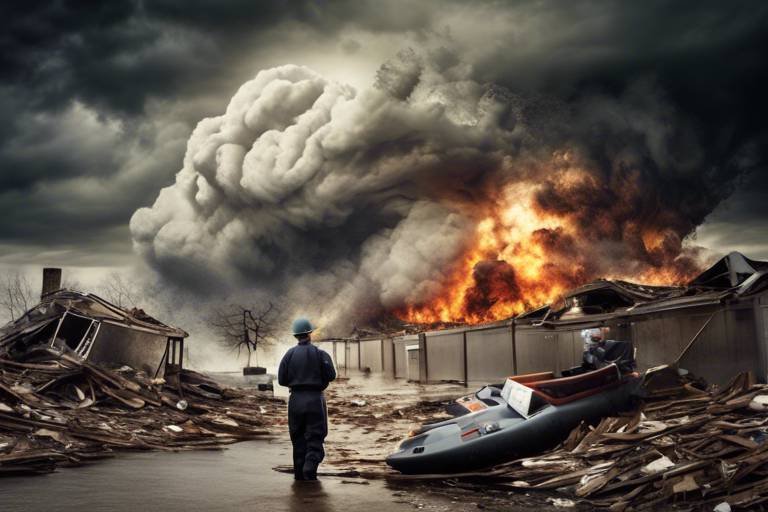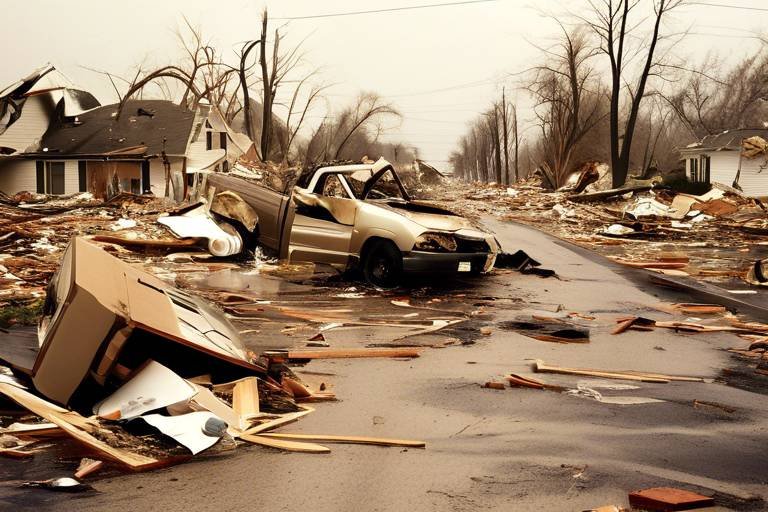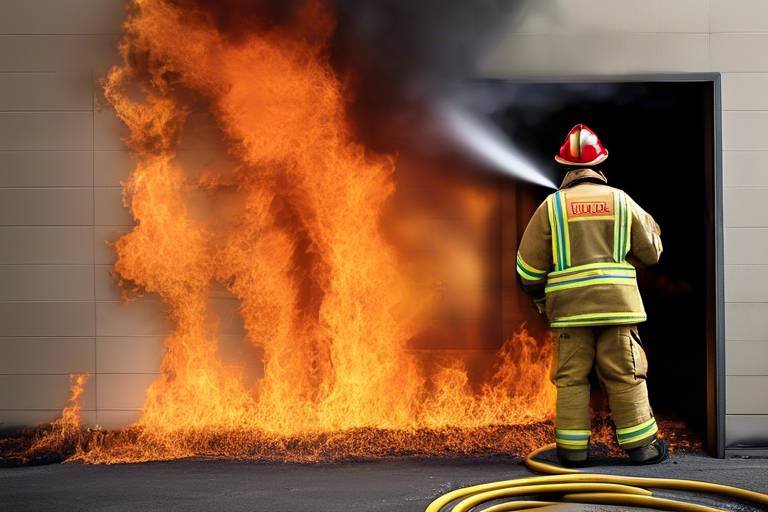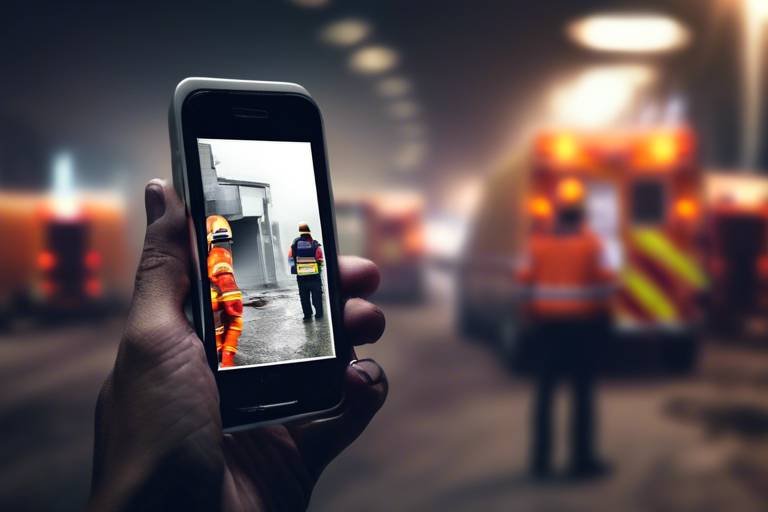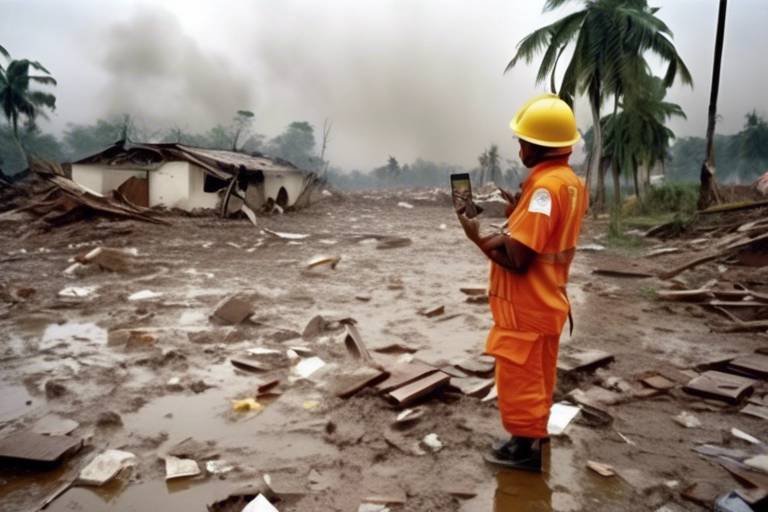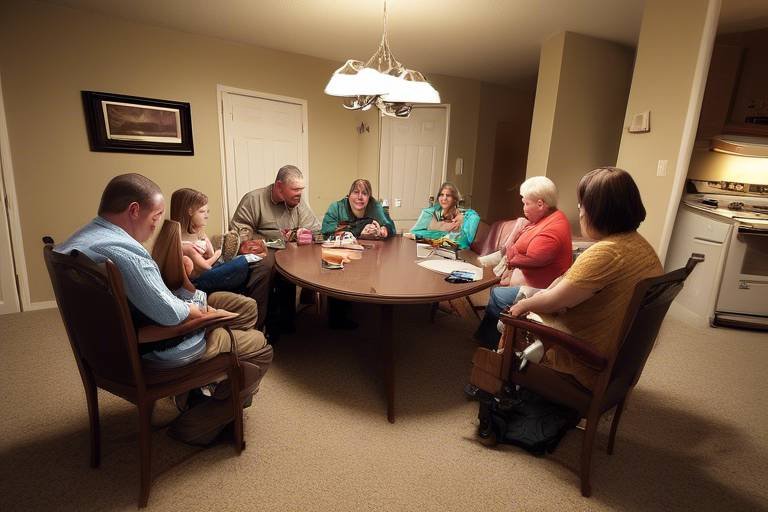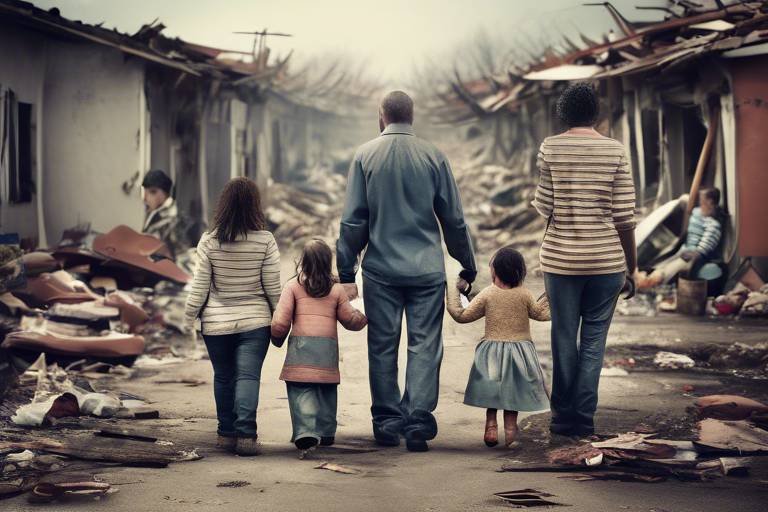Disaster Recovery – A Therapeutic Approach
When it comes to disaster recovery, the journey can often feel overwhelming and chaotic. But what if we approached this process not just as a logistical challenge but as a therapeutic opportunity? Imagine a world where recovery is not only about rebuilding structures but also about healing hearts and minds. In this article, we will delve into the therapeutic strategies and practices that can significantly aid in disaster recovery, focusing on mental health, community resilience, and effective coping mechanisms for individuals and communities affected by disasters.
Disasters can leave deep emotional scars, affecting individuals and communities alike. It’s essential to recognize that recovery is not just about the physical rebuilding of homes and infrastructure; it’s also about nurturing the mental health of those impacted. By integrating therapeutic approaches into recovery efforts, we can foster resilience and create a supportive environment that encourages healing. As we explore various strategies, we'll see how the power of community and individual coping mechanisms can transform the recovery experience into one of growth and strength.
Throughout the following sections, we will discuss the importance of mental health, the role of community resilience, and effective coping mechanisms. We will also highlight the significance of Psychological First Aid and how creative outlets can serve as a therapeutic tool. So, whether you are a survivor, a community leader, or someone who wants to understand the recovery process better, this article aims to provide valuable insights that can help navigate the complexities of disaster recovery.
Mental health plays a crucial role in disaster recovery. After a disaster strikes, individuals often experience a range of emotional responses, from shock and disbelief to anxiety and despair. Understanding how trauma affects individuals can lead to better support systems and therapeutic practices that promote healing and resilience. It’s vital to acknowledge that everyone processes trauma differently; some may find solace in talking about their experiences, while others might prefer solitude.
Providing mental health support is not just beneficial; it’s essential. Communities can implement programs that offer counseling services, support groups, and workshops focused on emotional well-being. These initiatives can help individuals feel less isolated and more connected to others who share similar experiences. Remember, recovery is a journey, and mental health is a vital component of that journey.
Community resilience is vital for effective disaster recovery. When a disaster strikes, the strength of a community can make all the difference in the recovery process. Collective actions, support networks, and shared resources can enhance recovery efforts and foster a sense of belonging among affected individuals. In times of crisis, it’s often the community that rallies together to provide support, whether through physical assistance or emotional encouragement.
Investing in community-building initiatives before disasters occur can significantly improve recovery outcomes. Imagine a community where neighbors know each other well, and there’s a strong network of support in place. This kind of environment can be cultivated through:
- Regular community events that encourage interaction.
- Volunteer programs that foster collaboration.
- Workshops aimed at building skills and knowledge.
These strategies not only enhance relationships among community members but also equip them with the tools they need to face challenges together. When everyone feels connected, the recovery process becomes a shared journey, making it less daunting.
Local organizations play an essential role in providing support during recovery. These groups often serve as the backbone of community resilience, mobilizing resources and offering assistance to affected individuals. They can coordinate relief efforts, provide information on available resources, and facilitate training programs that empower community members. It’s crucial to recognize the impact these organizations have in creating a structured recovery process.
Establishing support networks can facilitate information sharing and emotional support. By connecting individuals with similar experiences, these networks can help combat feelings of isolation and despair. Support networks can take various forms, such as:
- Online forums where people can share their stories.
- Local support groups that meet regularly.
- Peer mentoring programs that pair individuals with experienced survivors.
These networks play a pivotal role in fostering a sense of community and belonging, which is essential for effective recovery.
Psychological First Aid (PFA) is a critical intervention in disaster recovery. It focuses on providing immediate psychological support to individuals affected by disasters. The principles of PFA include:
- Assessing the needs of those affected.
- Listening actively and empathetically.
- Connecting individuals to resources and support.
By offering PFA, we can help individuals stabilize their emotions and begin the healing process, making it an invaluable tool in recovery efforts.
Coping mechanisms are essential for managing stress and trauma during recovery. Individuals can employ various strategies to navigate their emotional challenges effectively. These mechanisms not only help in managing immediate stress but also contribute to long-term resilience.
Mindfulness and relaxation techniques can significantly reduce anxiety and improve emotional well-being. Practices such as meditation, deep breathing exercises, and yoga can help individuals center themselves and regain a sense of control amidst chaos. These techniques encourage individuals to focus on the present moment, allowing them to process their emotions and experiences more effectively.
Engaging in creative activities can be therapeutic during disaster recovery. Art, music, and writing serve as powerful tools for expression and healing. These creative outlets allow individuals to communicate their feelings in a non-verbal way, often leading to profound insights and emotional release. Whether it's painting a picture, composing a song, or journaling, these activities can provide a much-needed escape and a way to process trauma.
Q: What is the first step in disaster recovery?
A: The first step is often to ensure safety and assess the immediate needs of those affected, followed by establishing a support system.
Q: How can I help my community recover after a disaster?
A: You can volunteer your time, donate resources, or simply offer emotional support to those in need.
Q: What are some effective coping strategies for individuals?
A: Effective coping strategies include mindfulness practices, engaging in creative activities, and seeking social support.

The Importance of Mental Health in Recovery
Mental health is not just a buzzword; it’s the backbone of effective disaster recovery. When a disaster strikes, the physical damage is often visible, but the emotional and psychological scars can run much deeper and may take longer to heal. Understanding how trauma impacts individuals is crucial for developing better support systems and therapeutic practices that promote healing and resilience. Imagine standing amidst the rubble of your home, the weight of loss pressing down on you like a heavy blanket. In such moments, mental health support becomes not just beneficial but essential.
After a disaster, many individuals experience a range of emotional responses, including shock, denial, anxiety, and depression. These reactions are normal, yet they can hinder the recovery process if not addressed. Recognizing the signs of trauma is the first step in providing the necessary support. It’s vital for both individuals and communities to be aware of how trauma manifests, which can include:
- Increased irritability or anger
- Difficulty concentrating
- Sleep disturbances
- Withdrawal from social interactions
- Physical symptoms like headaches or fatigue
By understanding these symptoms, communities can create a more supportive environment for those affected. For instance, schools can implement programs that focus on emotional well-being, while workplaces can offer mental health days to help employees cope. The goal is to foster a culture that prioritizes mental health just as much as physical health.
Moreover, integrating mental health services into disaster recovery plans is crucial. This can involve training first responders in basic mental health support, ensuring that psychological services are readily available in shelters, and creating community workshops that educate individuals on coping strategies. When mental health resources are accessible, individuals feel empowered to seek help, which can lead to quicker recovery times and a stronger community overall.
In summary, prioritizing mental health in disaster recovery is not just about addressing the immediate aftermath of a crisis; it’s about laying the foundation for long-term resilience. Just like a tree needs strong roots to withstand storms, individuals need robust mental health support to navigate the turbulent waters of recovery. By fostering understanding, building support systems, and integrating mental health into recovery plans, we can create a more resilient society that can bounce back from disasters, stronger than ever.
Q: Why is mental health important in disaster recovery?
A: Mental health is crucial because it affects how individuals cope with trauma. Addressing mental health can lead to quicker recovery and better overall community resilience.
Q: What are common signs of trauma?
A: Common signs include increased irritability, difficulty concentrating, sleep disturbances, social withdrawal, and physical symptoms like headaches.
Q: How can communities support mental health after a disaster?
A: Communities can support mental health by providing accessible resources, training first responders, and creating educational workshops focused on coping strategies.

Community Resilience and Support Systems
When disaster strikes, it’s not just the physical damage that needs to be addressed; the emotional and psychological toll on individuals and communities can be just as devastating. Community resilience refers to the ability of a community to withstand, adapt to, and recover from adverse situations. This resilience is built on strong support systems that foster connections among members, enabling them to face challenges together. Imagine a spider web: each thread represents an individual, and when one thread is pulled, the entire web holds together, absorbing the strain. This interconnectedness is what makes communities robust and capable of bouncing back.
One of the key elements of community resilience is the establishment of support networks. These networks can take many forms, from informal friendships to organized groups that provide resources and emotional support. When individuals know they are not alone in their struggles, it can significantly alleviate feelings of isolation and despair. For example, after a natural disaster, neighbors can come together to share information, provide meals, or offer a listening ear. Such collective actions not only help individuals cope but also strengthen the fabric of the community.
In addition to these informal connections, local organizations play a crucial role in mobilizing resources and offering assistance during recovery. These organizations often have established networks and can quickly respond to the needs of the community. They serve as a bridge between affected individuals and necessary resources, such as mental health services, food banks, and shelter. By coordinating efforts, these organizations can ensure that help reaches those who need it most, fostering a sense of unity and shared purpose.
It's important to note that building community resilience doesn't start only when a disaster occurs. Investing in community-building initiatives before disasters happen can significantly improve recovery outcomes. This proactive approach can include organizing workshops, community events, and training programs that encourage collaboration and connection among residents. When community members know each other and have established trust, they are more likely to come together in times of crisis.
To further illustrate the importance of community resilience and support systems, consider the following table that outlines key components:
| Component | Description |
|---|---|
| Support Networks | Informal and formal groups that provide emotional and practical support. |
| Local Organizations | Groups that mobilize resources and coordinate recovery efforts. |
| Community-Building Initiatives | Proactive efforts to foster connections and trust among residents. |
Ultimately, the strength of a community lies in its ability to come together during challenging times. By fostering relationships, creating support networks, and engaging with local organizations, communities can enhance their resilience. This collective spirit not only aids in recovery but also promotes a sense of belonging and shared identity. When people feel connected, they are more likely to support one another, creating a ripple effect of positivity and strength that can carry them through even the toughest of times.
- What is community resilience? Community resilience is the ability of a community to withstand and recover from adverse situations, such as disasters.
- How can I help build community resilience? You can participate in community events, volunteer with local organizations, and foster connections with your neighbors.
- What role do local organizations play in disaster recovery? Local organizations mobilize resources, provide support, and coordinate recovery efforts to help affected individuals.

Building Stronger Communities
When it comes to disaster recovery, the idea of community isn't just a buzzword; it's a lifeline. Think about it: when a disaster strikes, what do we crave most? Connection. Support. A sense of belonging. That's why investing in community-building initiatives before disasters hit can be a game changer. It's like planting seeds in a garden; the stronger the roots, the better the blooms will be after the storm. So, how do we cultivate these connections? Let's dive in!
First off, fostering a sense of community starts with creating opportunities for people to come together. This can be achieved through various activities such as neighborhood clean-ups, potlucks, or local workshops. Imagine a community where everyone knows their neighbors, where families share meals, and individuals collaborate on projects. This kind of environment not only strengthens bonds but also builds trust, which is crucial when the going gets tough.
Moreover, collaboration is key. By encouraging local organizations and businesses to work together, communities can pool their resources and knowledge. For instance, a local school might partner with a nearby health clinic to offer wellness workshops. This not only enhances community ties but also equips residents with valuable skills and information that can aid in recovery. Just picture the impact of a community where everyone is looking out for one another, sharing resources, and supporting each other through thick and thin.
Another vital aspect is to embrace inclusivity. A strong community is one that welcomes diversity and values every voice. By ensuring that all community members, regardless of their background, have a seat at the table, we can create a richer, more resilient environment. This could mean organizing forums or discussion groups where everyone can share their experiences and ideas. The more perspectives we include, the stronger our community becomes.
Finally, let’s not forget the power of communication. Establishing clear channels for information sharing can make a world of difference during recovery efforts. Whether it’s through social media groups, community newsletters, or local radio stations, having reliable sources of information helps keep everyone informed and engaged. Imagine a community where everyone is updated on recovery resources, volunteer opportunities, and emotional support services. It’s like being part of a well-oiled machine!
In summary, building stronger communities is about more than just surviving a disaster; it’s about thriving in its aftermath. By fostering connections, encouraging collaboration, embracing inclusivity, and ensuring effective communication, communities can not only recover but emerge even more resilient. So, let’s roll up our sleeves and start planting those seeds today!
- What are some effective ways to build community before a disaster? Organizing local events, creating neighborhood groups, and fostering relationships between local organizations are excellent starting points.
- How can I get involved in my community's disaster preparedness efforts? Look for local volunteer opportunities, attend community meetings, and connect with local organizations focused on disaster recovery.
- Why is communication important in disaster recovery? Clear communication helps keep everyone informed about available resources, recovery efforts, and emotional support, which is crucial for effective recovery.

Role of Local Organizations
Local organizations are the backbone of disaster recovery efforts. When a disaster strikes, these groups spring into action, providing essential services and support to affected individuals and families. They often have established relationships within the community, which allows them to mobilize quickly and effectively. Imagine a tightly-knit neighborhood where everyone knows each other; when disaster hits, these local organizations become the glue that holds the community together, ensuring that no one is left behind.
One of the key roles of local organizations is to coordinate relief efforts. They work with government agencies, non-profits, and volunteers to streamline the distribution of resources such as food, shelter, and medical assistance. This coordination is vital because it prevents duplication of efforts and ensures that resources reach those who need them most. For example, during a recent natural disaster, a local organization might have organized a community meeting to assess needs, leading to a more effective allocation of resources.
Additionally, local organizations provide emotional and psychological support to individuals coping with trauma. They often host support groups, counseling sessions, and workshops aimed at helping people process their experiences and begin the healing journey. The presence of trained professionals and volunteers who understand the unique challenges faced by disaster survivors can make a world of difference. It's like having a trusted friend who listens and offers guidance during a tough time.
Moreover, these organizations often serve as a hub for information. They disseminate critical updates about recovery efforts, available services, and safety information. This is especially important in the chaotic aftermath of a disaster when misinformation can spread quickly. By acting as a reliable source of information, local organizations help to alleviate confusion and empower individuals to make informed decisions about their recovery.
In addition to immediate relief, local organizations play a crucial role in long-term recovery and rebuilding efforts. They often engage in community planning and development initiatives that focus on resilience. For instance, they may advocate for improved infrastructure, disaster preparedness training, and other measures designed to reduce vulnerability to future disasters. This proactive approach not only aids in recovery but also strengthens the community's ability to withstand future challenges.
In summary, local organizations are indispensable in the disaster recovery process. Their ability to provide immediate assistance, emotional support, and long-term planning makes them vital partners in building resilient communities. Without these dedicated groups, recovery would be significantly more challenging, and the path to healing would be much longer. As we reflect on the importance of these organizations, it becomes clear that investing in their capacity and fostering collaboration among them is essential for effective disaster recovery.
- What types of local organizations are involved in disaster recovery? Local organizations can include non-profits, faith-based groups, community centers, and volunteer networks.
- How can I support local organizations during a disaster? You can support them by volunteering your time, donating resources, or spreading the word about their initiatives.
- What role do local organizations play in mental health support? They often provide counseling services, support groups, and workshops to help individuals cope with trauma and stress.

Creating Support Networks
Creating effective support networks is essential for fostering resilience and promoting recovery in the aftermath of disasters. These networks serve as lifelines for individuals and communities, providing not only emotional support but also practical assistance. Imagine a web of connections, where each thread represents a person or organization ready to lend a hand when times get tough. This web can catch those who might otherwise fall through the cracks, ensuring that no one faces their struggles alone.
One of the first steps in establishing these networks is to identify key community members and organizations that can act as pillars of support. This includes local leaders, mental health professionals, and volunteers who are willing to contribute their time and resources. By bringing together a diverse group of people, you create a rich tapestry of skills and experiences that can be tapped into during recovery efforts.
Moreover, it’s crucial to facilitate open communication within these networks. Regular meetings, whether in-person or virtual, can help maintain connections and ensure that everyone is on the same page. This is where technology can play a significant role—using social media platforms, community apps, or even simple group chats can keep the lines of communication open. Sharing updates, resources, and emotional check-ins can help members feel connected and supported.
Additionally, creating a centralized resource hub can streamline the recovery process. This hub can include important information such as:
- Available mental health services
- Local emergency contacts
- Volunteer opportunities
- Community events aimed at fostering connection
By having all this information in one place, individuals can easily access the help they need, reducing feelings of isolation and confusion during a chaotic time.
Furthermore, encouraging community members to share their stories can be incredibly powerful. Personal narratives not only validate experiences but also foster empathy and understanding among individuals. When people hear about others’ struggles and triumphs, it can inspire them to reach out, offer help, or seek support themselves. Consider organizing storytelling events or support group meetings where individuals can come together to share their experiences and learn from one another.
Ultimately, creating support networks is about building relationships and fostering a sense of belonging. It’s about ensuring that everyone knows they are not alone in their journey toward recovery. By investing time and effort into these networks, communities can emerge stronger and more united, ready to face whatever challenges may come their way in the future.
- What is a support network? A support network is a group of individuals and organizations that provide emotional, informational, and practical assistance to those in need, especially during challenging times.
- How can I get involved in creating a support network? You can start by reaching out to local organizations, attending community meetings, and connecting with individuals who share a passion for helping others.
- Why are support networks important in disaster recovery? Support networks help reduce feelings of isolation, provide essential resources, and foster a sense of community, which is crucial for emotional and practical recovery.

Psychological First Aid
Psychological First Aid (PFA) is an essential intervention designed to support individuals in the aftermath of a disaster. It focuses on providing immediate emotional support and practical assistance to those affected. Imagine being caught in a storm; the winds are howling, and the rain is pouring down. What you need most is someone to hold your hand and guide you to safety. That's precisely what PFA aims to do—act as a guiding light in the chaos.
The principles of PFA are rooted in compassion and understanding. It recognizes that disasters can leave individuals feeling overwhelmed, anxious, and isolated. PFA practitioners are trained to listen, offer comfort, and help individuals identify their immediate needs. This approach is not about delving into deep psychological issues but rather about being present and providing a sense of stability. In this way, PFA can be likened to a warm blanket on a cold night, offering comfort and reassurance in a time of distress.
One of the key components of PFA is the emphasis on creating a safe environment. This includes ensuring that individuals feel secure and respected, which can significantly alleviate feelings of anxiety. When someone is experiencing a crisis, the last thing they need is to feel judged or misunderstood. The goal of PFA is to foster a supportive atmosphere where individuals can express their feelings without fear.
Moreover, PFA involves practical assistance, which can take various forms, such as:
- Providing information about available resources
- Connecting individuals with local support services
- Encouraging engagement with community resources
This practical support is crucial because, during times of crisis, individuals may not know where to turn for help. By guiding them to the right resources, PFA helps empower individuals to take the next steps in their recovery journey.
Research has shown that providing PFA can lead to improved emotional outcomes for those affected by disasters. It can reduce the risk of developing long-term mental health issues, such as Post-Traumatic Stress Disorder (PTSD). The immediate impact of PFA can be likened to a soothing balm on a fresh wound, promoting healing and recovery right from the start.
In conclusion, Psychological First Aid is a vital tool in disaster recovery. It serves not only to address immediate emotional needs but also to lay the groundwork for long-term recovery. By fostering resilience and providing practical support, PFA can make a significant difference in the lives of individuals affected by disasters. Just as a sturdy bridge can withstand the strongest of storms, PFA helps individuals navigate the turbulent waters of their emotions, guiding them toward a safer, more stable future.
What is Psychological First Aid?
Psychological First Aid (PFA) is an immediate support intervention aimed at helping individuals cope with the emotional impact of disasters. It focuses on providing comfort, practical assistance, and information about available resources.
Who can provide PFA?
PFA can be provided by trained professionals, volunteers, or community members who are equipped to offer emotional support and guidance to those affected by a disaster.
How does PFA differ from traditional therapy?
Unlike traditional therapy, which often involves in-depth discussions and long-term treatment, PFA is designed for immediate response. It focuses on providing support and resources in the aftermath of a crisis rather than addressing deeper psychological issues.
Can PFA prevent mental health issues?
While PFA cannot guarantee the prevention of mental health issues, research indicates that it can significantly reduce the risk of developing long-term problems such as PTSD by providing immediate support and resources.

Effective Coping Mechanisms
When faced with the aftermath of a disaster, it’s **natural** to feel overwhelmed, anxious, or even lost. The emotional toll can be significant, but understanding and implementing effective coping mechanisms can make a world of difference in navigating these challenging times. Think of coping mechanisms as your personal toolbox, filled with various tools you can use to help mend the emotional and psychological damage caused by traumatic experiences. Each tool serves a unique purpose, and knowing when to use each one is key to your recovery journey.
One of the most effective coping strategies is developing a **routine**. Establishing a daily schedule can provide a sense of normalcy amidst the chaos. Just like a ship needs a compass to navigate through stormy seas, routines can guide individuals back to stability. Incorporating small, manageable tasks into your day can foster a feeling of accomplishment and control. For instance, setting aside time for self-care activities like cooking a meal, taking a walk, or even reading a book can help ground you. It’s essential to remember that these small steps are not insignificant; they are the building blocks of recovery.
Another powerful coping mechanism is **connecting** with others. Isolation can exacerbate feelings of distress, so reaching out to friends, family, or support groups can be incredibly beneficial. Sharing your feelings and experiences with others who have gone through similar situations can create a sense of community and belonging. You might consider joining a local support group or participating in community events focused on recovery. As the saying goes, “a problem shared is a problem halved.” This connection not only promotes healing but also reinforces the idea that you are not alone in your struggles.
Additionally, engaging in **mindfulness and relaxation techniques** can significantly help in managing stress. These practices encourage you to stay present and grounded, allowing you to process emotions without becoming overwhelmed. Techniques such as deep breathing, meditation, or yoga can be particularly effective. Imagine mindfulness as a gentle breeze that calms the turbulent waters of your mind. By focusing on your breath or the sensations in your body, you can create a safe space to explore and understand your feelings. If you’re new to mindfulness, consider starting with just a few minutes each day and gradually increasing the time as you become more comfortable.
Creative outlets also play a crucial role in disaster recovery. **Engaging in artistic activities** such as painting, writing, or playing music can serve as therapeutic channels for expressing emotions that may be difficult to articulate verbally. Creativity allows you to transform pain into beauty, offering a unique form of release and healing. For example, writing in a journal can help you process your thoughts and feelings, while painting can provide a visual representation of your emotional landscape. These activities can be incredibly cathartic, allowing you to explore your experiences in a safe and constructive way.
In summary, effective coping mechanisms are vital in the journey toward recovery after a disaster. By establishing routines, connecting with others, practicing mindfulness, and engaging in creative activities, individuals can navigate their emotional challenges more effectively. Remember, recovery is not a linear path; it’s filled with ups and downs. Embrace each step, no matter how small, and be gentle with yourself as you heal.
- What are some quick coping strategies I can use in the moment? Deep breathing, grounding techniques, and taking a short walk can help calm immediate anxiety.
- How can I find support groups in my area? Look for local organizations, community centers, or online platforms that connect individuals with similar experiences.
- Is it normal to feel overwhelmed after a disaster? Yes, it’s completely normal. Acknowledging your feelings is the first step toward healing.

Mindfulness and Relaxation Techniques
In the whirlwind of disaster recovery, emerge as essential tools for restoring emotional balance and fostering resilience. Imagine your mind as a busy highway, with thoughts racing by at breakneck speed. Mindfulness acts as a traffic signal, allowing you to pause, reflect, and choose which thoughts to engage with. By practicing mindfulness, individuals can cultivate a greater awareness of their thoughts and feelings, leading to a profound sense of calm amidst chaos.
One of the most effective mindfulness techniques is deep breathing. This simple yet powerful practice can be done anywhere and at any time. When you focus on your breath, you ground yourself in the present moment, which can significantly reduce anxiety. Picture this: take a deep breath in, hold it for a few seconds, and then slowly exhale. With each breath, you release tension and invite tranquility into your mind and body. This technique can be particularly helpful during moments of overwhelming stress, as it provides a quick escape from negative thoughts.
Another valuable practice is guided imagery. This technique involves visualizing a peaceful scene, such as a serene beach or a tranquil forest. By immersing yourself in this mental landscape, you can create a sense of safety and relaxation. You might find it helpful to close your eyes and imagine the sound of waves crashing or the scent of pine trees. This mental exercise not only distracts you from distressing thoughts but also promotes emotional healing.
Incorporating progressive muscle relaxation into your routine can also yield remarkable benefits. This method involves tensing and then relaxing each muscle group, helping to release physical tension that often accompanies emotional stress. Start from your toes and work your way up to your head, paying attention to how each muscle feels as you relax it. This practice not only helps you connect with your body but also enhances your overall sense of well-being.
For those who enjoy a more structured approach, mindfulness meditation can be a game-changer. Setting aside just a few minutes each day to meditate can transform your mental landscape. You can sit quietly, focus on your breath, and gently bring your mind back whenever it wanders. This practice cultivates patience and allows you to observe your thoughts without judgment. Over time, you may find that you respond to stressors with greater clarity and calmness.
Lastly, consider integrating yoga into your recovery routine. Yoga combines physical movement with breath awareness, creating a holistic practice that nurtures both body and mind. Whether you choose a gentle restorative class or a more vigorous flow, yoga encourages you to tune into your body’s sensations and release pent-up emotions. The physical postures, paired with mindful breathing, can significantly enhance your emotional resilience.
Incorporating these mindfulness and relaxation techniques into your daily life can help you navigate the emotional challenges of disaster recovery more effectively. Remember, just like a muscle, mindfulness requires practice and patience. Start small, and gradually build a routine that resonates with you. By doing so, you’ll not only aid your recovery but also foster a deeper connection with yourself and the world around you.
- What is mindfulness? Mindfulness is the practice of being present and fully engaged with the current moment, without judgment.
- How can I start practicing mindfulness? You can start by setting aside a few minutes each day to focus on your breath or engage in guided meditation.
- Are relaxation techniques effective for everyone? While they can be beneficial for many, individual experiences may vary. It's essential to find what works best for you.
- How often should I practice mindfulness? Regular practice is key. Aim for a few minutes daily, gradually increasing as you become more comfortable.

Engaging in Creative Outlets
When disaster strikes, the emotional toll can be overwhelming. One of the most effective ways to cope with such distress is through engaging in creative outlets. These activities not only provide a distraction but also serve as a powerful form of expression, allowing individuals to process their feelings and experiences in a constructive manner. Think of creativity as a lifeboat in a turbulent sea; it helps us navigate the waves of trauma and uncertainty.
Whether it’s painting, writing, playing music, or even dancing, creative activities can foster a sense of agency and control during chaotic times. They allow individuals to channel their emotions into something tangible, providing a sense of accomplishment and purpose. For instance, someone affected by a disaster might find solace in writing poetry that reflects their journey, or perhaps they might pick up a paintbrush to visually depict their feelings. Such activities can be incredibly therapeutic, serving as a bridge between the chaos of their experiences and the calm of self-expression.
Moreover, engaging in creative outlets can also promote social connections. Many communities organize art therapy sessions, writing workshops, or music groups specifically designed for disaster survivors. These gatherings not only facilitate creative expression but also foster a sense of belonging and community support. When people come together to share their stories through art, they create a network of understanding and empathy, which is crucial for healing.
Here are some creative outlets that can be particularly beneficial during disaster recovery:
- Art Therapy: Utilizing various art forms to express feelings and emotions.
- Music Therapy: Engaging in music creation or listening to aid emotional healing.
- Writing: Journaling or storytelling as a means of processing experiences.
- Dance and Movement: Physical expression to release pent-up emotions.
In addition to the emotional benefits, these activities can also enhance cognitive functioning. Engaging in creative tasks stimulates the brain, allowing individuals to think more clearly and develop problem-solving skills. This is particularly important in recovery, where individuals must navigate complex emotional and logistical challenges. The act of creating can help to clear mental fog, providing clarity and focus.
In conclusion, engaging in creative outlets is not merely a pastime; it is a vital component of disaster recovery. It allows individuals to reclaim their narratives, connect with others, and foster their emotional well-being. So, if you or someone you know is struggling in the aftermath of a disaster, consider picking up a brush, pen, or instrument. You might just find that creativity is the key to unlocking resilience and healing.
Q: How can I start engaging in creative outlets if I have no experience?
A: Start small! Choose an activity that intrigues you, like doodling or journaling. The key is to focus on the process rather than the outcome—just let your creativity flow.
Q: Is there a specific type of art that is most effective for healing?
A: There’s no one-size-fits-all answer! Different forms of art resonate with different people. Experiment with various mediums—painting, writing, or music—and see what feels right for you.
Q: Can creative outlets help with long-term recovery?
A: Absolutely! Engaging in creative activities can have lasting benefits, helping individuals process their experiences and emotions long after the immediate crisis has passed.
Frequently Asked Questions
- What is the role of mental health in disaster recovery?
Mental health is a cornerstone of effective disaster recovery. It influences how individuals process trauma and cope with stress, making it essential to provide adequate support systems. Understanding the psychological impacts can lead to better therapeutic practices that help individuals heal and build resilience.
- How can communities enhance their resilience during disasters?
Communities can enhance their resilience by fostering strong connections among members, creating support networks, and sharing resources. Engaging in community-building initiatives before disasters strike can significantly improve recovery outcomes, allowing individuals to rely on each other for support and assistance.
- What is Psychological First Aid (PFA) and why is it important?
Psychological First Aid (PFA) is an immediate response technique that provides psychological support to individuals affected by disasters. It helps mitigate the impact of trauma by offering comfort, information, and resources. PFA is crucial as it sets the foundation for long-term recovery and healing.
- What coping mechanisms can individuals use during recovery?
Individuals can employ various coping mechanisms such as mindfulness practices, relaxation techniques, and engaging in creative outlets like art or writing. These strategies can help manage stress and facilitate emotional healing, allowing individuals to navigate their recovery journey more effectively.
- How can engaging in creative activities aid in recovery?
Creative activities like art, music, and writing provide a powerful means of expression that can be therapeutic during recovery. They allow individuals to process their emotions, share their experiences, and find solace, ultimately contributing to their healing journey.

